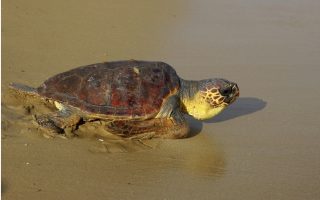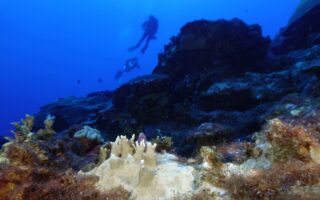Wild Attica sounds the environmental alarm bell

A collection of photographs taken to mark European Natura 2000 Day on May 21 came as an apt reminder of the importance of the European Union’s introduction of the initiative in 2000 to designate protected areas of special ecological importance. Taken for the incredibly successful competition that has been run for the past three years by the Greek branch of the World Wide Fund for Nature (WWF) and dedicated to the Natura 2000 areas in the country’s capital, the candid shots of deer, wolves, remarkable trees and more got me thinking: Do we really know how rich Attica is in natural treasures?
Greece has a total of 446 Natura 2000 habitats covering around 28% of its land and 20% of its sea area; 17% of them are in Attica, says Eleni Koumoutsou, the area director for protected zones at the Natural Environment and Climate Change Agency (NECCA).

I spent my teens in Dionysos, a suburb in the foothills of Mount Penteli, in northeastern Athens. The occasional fox coming out just before sunset was taken as a sign of good luck, but it never crossed my mind to follow the elusive creatures into the woods where they invariably fled. It was as if there were an invisible barrier stopping me from venturing beyond the treeline. Like most of the humans in this area and beyond, I preferred to spend my time at the local cafes, tavernas and bars, oblivious to the abundance of natural treasures held by this and other habitats on the city’s fringes.
But wetlands, rare species of plants and a wealth of wildlife have always been an intrinsic part of Attica’s natural landscape. Would raising awareness about the presence of such impressive natural landscapes help protect them? Or would it pile on more risks to these already endangered habitats?
“No! It is essential for both Athenians and visitors to know that the city is not just about the Acropolis, but has so many hidden natural treasures right on its doorstep,” says Koumoutsou.

Vravrona, Legrena, the islands of the Saronic Gulf and Makronisos, the Geraneia mountains and the much closer Mount Ymittos are just a few of the areas hosting Natura-protected habitats in and around the Greek capital. Some, like many parts of Mount Parnitha, get more visitors than they can handle during holidays and weekends, while others, like the caves of Ymittos, are largely unknown.
But why are all these areas so important?
“The Schinias-Marathon National Park, just 40 kilometers from the city center, is one of Attica’s most important coastal ecosystems for significant plant and animal species. It contains two Natura 2000 areas and hosts 22 different types of habitats within its borders, while the pine forest with the sand dunes is one of just a few that remain in the Mediterranean. It is, to put it simply, an area with a rare wealth of biodiversity that deserves our protection,” explains Koumoutsou.
Mount Parnitha is equally valuable, she adds.
“It hosts some 1,200 species and subspecies of plants, including two which are not found anywhere else in the world, the Parnitha bellflower and the Parnitha catchfly,” she says.

It is also Attica’s most important wildlife habitat, hosting 42 of the country’s 116 species of mammals, 12 types of reptile and seven amphibians. Moreover, the endangered red deer, which is protected under the relevant Greek and international conventions, has been thriving on Mount Parnitha over recent years.
The big threats
One of the greatest threats to these habitats is wildfire, notes Koumoutsou, expressing concern that unseasonably high temperatures over the spring bode ill for the summer that lies ahead.
“Efforts to restore Parnitha to its previous state after the devastating fire of 2007 via natural and artificial regeneration initiatives suffered two enormous setbacks because of the fires in 2021 and 2022. They razed large areas inside the protected zone and had a very big impact on the animal population,” she says.

Apart from fires, it seems that uncontrolled crowds have the same kind of negative impact on natural habitats that unfettered tourist numbers have on sensitive historical sites: They pose a threat, perhaps even to their very existence.
“There are barriers that prevent too many visitors during peak periods like the summer both at Parnitha and at Schinias, though our opinion is that a more comprehensive visitor management system is needed, in cooperation with all the different agencies involved. Scenes of cars packing the roadsides leading to Parnitha on weekends and holidays, leaving no room for animals to escape the throngs, are not what we like to see. It puts a tremendous strain on the ecosystem and on the animals living in it,” says Koumoutsou.
For a better tomorrow
Keeping people away from nature is not the objective, however. Controlling their impact on it is the issue. For Koumoutsou, it is essential that people learn about the plants and animals that live around them and especially from a young age. They should know that the Saronic is home to cormorants and kestrels or that Makronisos is an important haven for the Mediterranean monk seal, a species with a global population of just 800 or so, of which 450 are estimated to live in Greece.

“A connection to the natural ecosystems is essential for educational reasons, both for young visitors and their adult chaperones,” she says.
Apart from their importance to animals, these habitats also provide the humans in Attica with oxygen and so much more. “We won’t be able to survive here if we destroy them; it will be like destroying our own homes,” Koumoutsou stresses.

Preserving our natural allies against the threat of climate change is more important than ever right now, but if we want to be serious about this, we need to cross the invisible barrier and get to know the earliest residents of Attica, the creatures great and small that have lived here for thousands of years before we appeared. Before even the myths of the ancient Greeks, whose protagonists are, of course, the wolf, the fox, the deer, the tortoise, the owl…
The original, Greek version of this article first appeared in K, Kathimerini’s Sunday supplement.





